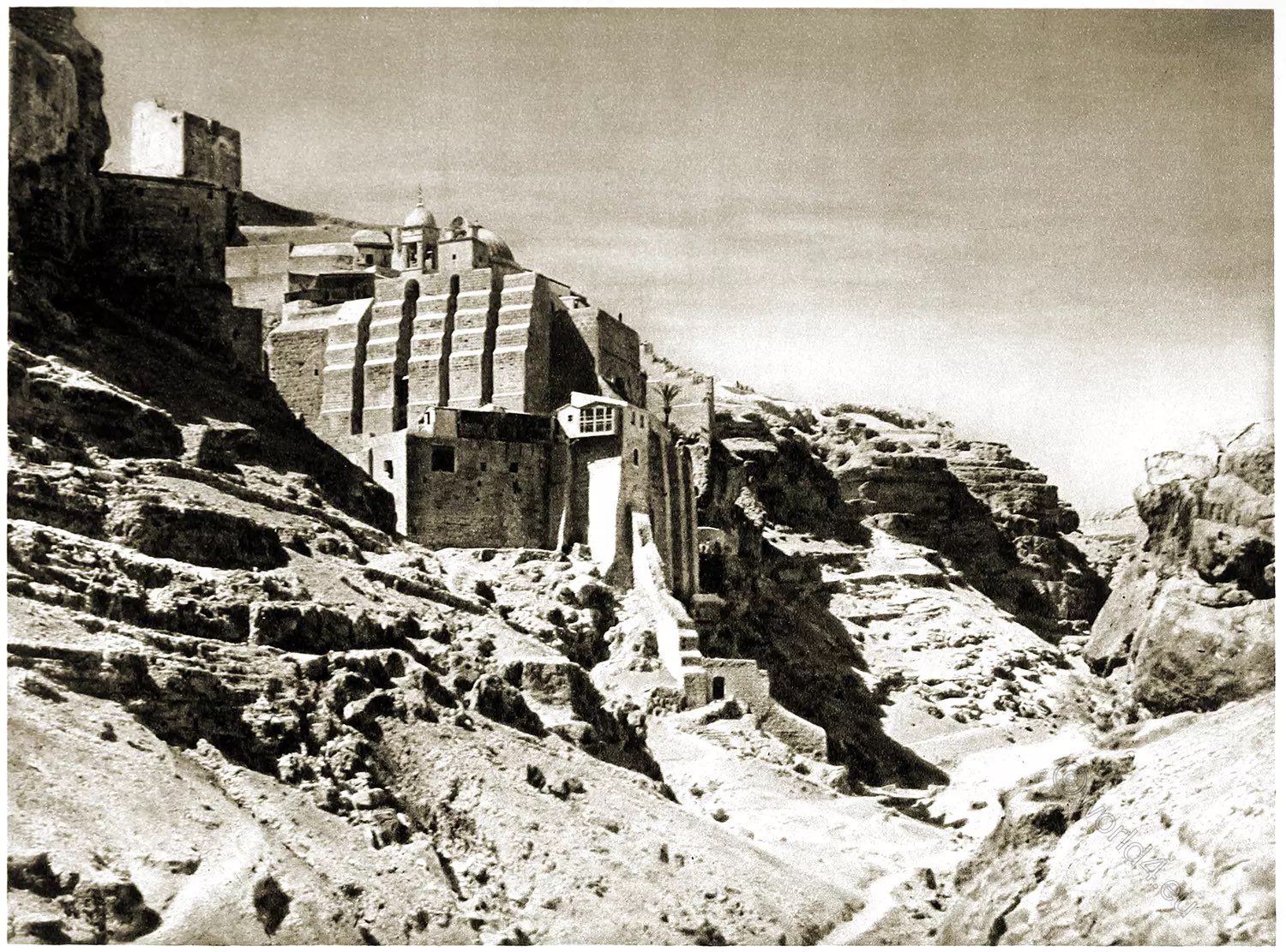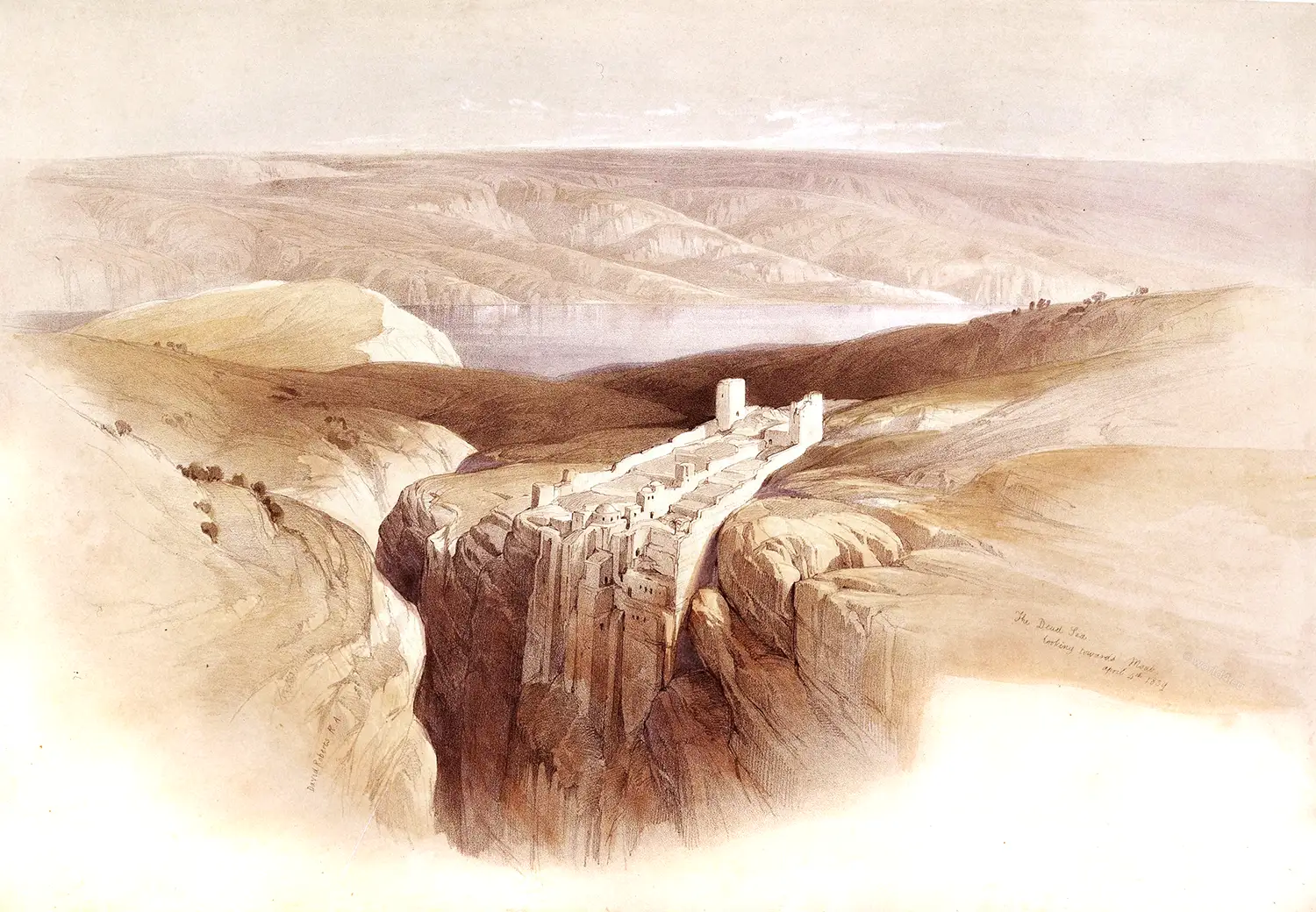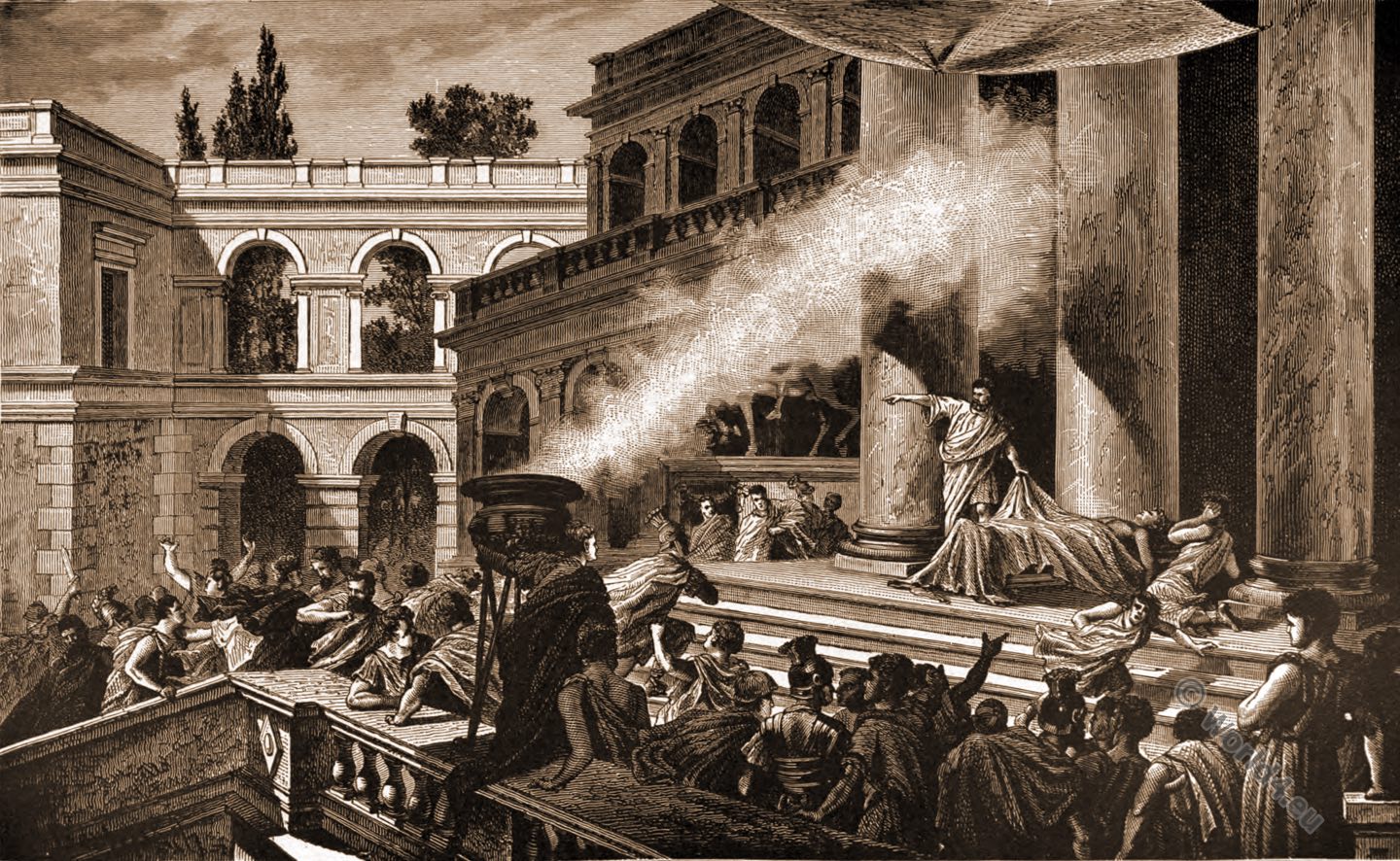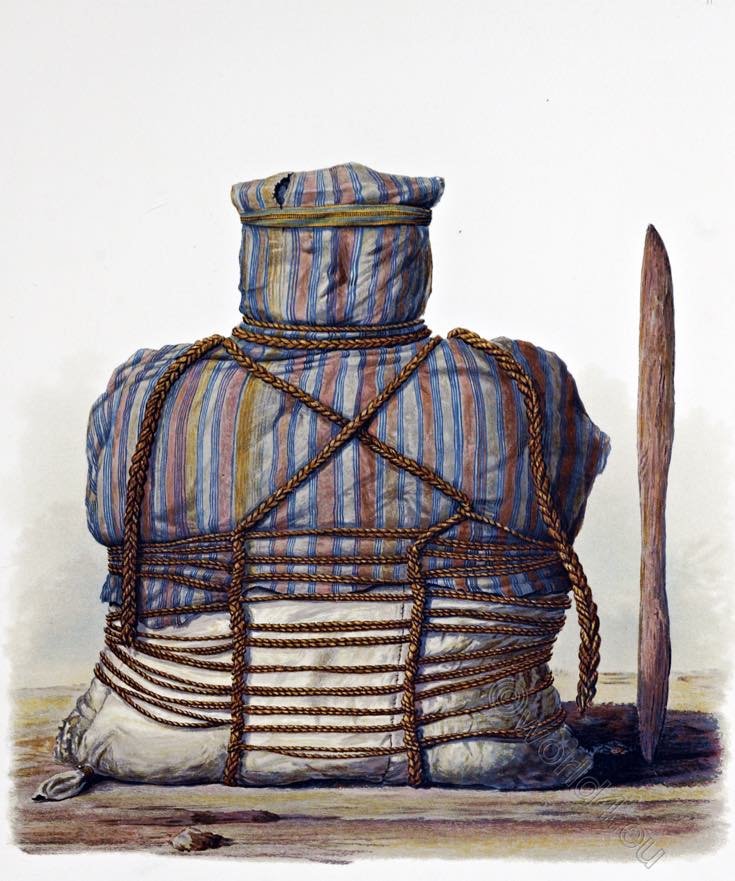The Laura of Mar Saba near the Dead Sea.
by Theodore Edward Dowling.
Nine and a half miles, on horseback, from Jerusalem in the unique grandeur of its situation (the Wilderness of Engedi, near the Dead Sea), the Laura *) of Mar Saba, clinging to the precipitous side of Wâdy en Nâr, as the Kedron is called, has the most weird appearance of any Palestinian group of buildings. From the fifth century it has been a renowned settlement of Greek monks.
*) Lawra, also Lavra, Laura or Laure (Cyrillic Лавра, from Ancient Greek Λαύρα ‘street, alley, corridor’) is, in early Christian and later Orthodox monasticism, a place inhabited by a colony of hermits in the form of cells or grottoes in which the monks live separately from one another as anachoretes, but celebrate the liturgy together and are also subject to a common abbot (abbas).
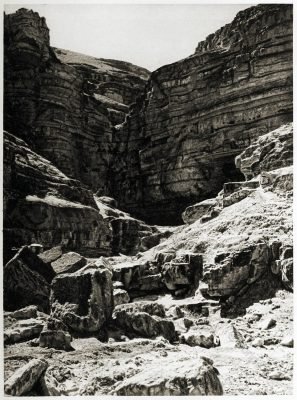
In A.D. 1106 or 1107, when Daniel, Abbot of a Russian Monastery, visited Palestine, during his pilgrimage, he was deeply impressed with this Laura: “A dry torrent-bed, terrible to behold, and very deep, shut in by high walls of rock, to which the cells are fixed and kept in place by the hand of God, in a surprising and fearful manner.”
St. Sabas, its founder, was a native of Mutalasca, Cappadocia, having been born A.D. 437. He, as well as St. Theodosius, was a disciple of St. Euthymius, whose restored Laura may be seen farther up the same gorge. After the death of his master in A.D. 474, St. Sabas attracted 500 hermits, who came to partake of his solitude. Their cells, like birds’ nests, are still to be seen in the clefts of the rock.
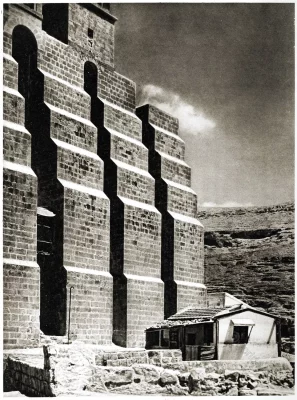
The Patriarch Sallastius ordained St. Sabas priest, and appointed him “Abbot of all the Palestinian Anchorites,” a.d. 491. It was then that the Saint established himself in the Laura, which now bears his name, as a centre of his administration.
St. Theodosius was at the same time appointed to the charge of the Coenobites. (The fourth stage of the Ascetic life is known as the Coenobite. It is the life of a community. Poverty and chastity were observed by the earlier Anchorites. Obedience came in with the common life of the Coenobites.)

St. Sabas entered into rest at the age of 94, December 5, A.D. 532, after having distinguished himself in theological controversies against the Monophysites. His body was eventually removed to Venice.
Cyril, of Scythopolis (A.D. 557) *) was the biographer of St. Sabas. His name adorns the Byzantine Kalendar on December 5 as “Our GOD-bearing Father, Sabbas the Sanctified.” Cyril tells the familiar story of St. Sabas and the lion. The cave first occupied by the Saint at Deir Mar Saba was originally a lion’s den. It was in actual occupation of the monarch of the wilderness when St. Sabas first visited the spot, with the intention of founding a religious house. The Saint was satisfied that the grotto would serve as his headquarters, and he politely hinted to its occupant that it would be necessary for him to depart. The lion quickly took the hint, and left his lair to its higher destiny.
*) This Cyril must not be confounded with St. Cyril of Jerusalem, A.D. 351-386.
It is remarkable how many Palestinian hermits and other recluses of the fifth century are associated with lions. I need only mention St. Gerasimus, an Abbot on the Jordan; St. John the Silent, of Mar Saba; and St. Jerome in his Bethlehem cell.
*) The rule at this Laura is severe. There is only one authorised meal each day, between 9-10 a.m., and meat is never allowed. No woman is admitted within the low portal, with its heavy iron door.
*) The delightful story of St. Jerome and his lion is graphically told in The Life of St. Jerome, Discourse the Eighth. London : Sands & Co., 1907. The thick jungle-forests of the Jordan were the glory of its banks. Hence “Behold, he shall come up like a lion from the swelling of Jordan”: Jer. xlix. 19. See also ch. 1. 44 ; Zech. xi. 3. Historians of the twelfth century mention lions in connection with Samaria. Since crusading days they have become extinct.






It has, unfortunately, been often alleged that this solitary spot has been turned to disciplinary purposes. I take the opportunity of stating that this is the case only in the very limited degree that members of the Community are occasionally brought there either for removal from temptation, or in consequence of some irregularity of conduct. It is rather considered as a refuge of retirement for those who by age, or temperament, wish for solitude and meditation.
Having been pillaged by Arab marauders during A.D. 614, 796,*) 842, 1832, and 1834, this exceptionally interesting group of buildings was enlarged and restored during A.D. 1840.
*) The neighbouring Arabs in 796 shut up the monks in a cavern, and, kindling faggots at the entrance, smothered many of them alive, and subjected the rest to horrible torments. On this occasion quantities of valuable manuscripts were burnt, and the Library was transferred in 1891, for greater security, to the Convent of St. Constantine, Jerusalem.
Mar Saba is a place of special sanctity to Russian pilgrims. It contains a Chapel consisting chiefly of a grotto in the rock, commemorating St. Niccolas. St. Nicolaus of Myra is the patron saint of Russia, where he is known as St. Nicolas of Mojaisk. He entered into rest c. A.D. 342, and on December 6 “Our Father Nicolas, B. of Myra in Lycia, and Wonderworker” is commemorated in the Byzantine kalendar. It may be remembered that St. John Damascene, to whom another Chapel is dedicated, died in his cell, A.D. 780, and was buried in the Church of this Laura.
At present the Laura is occupied by seventy monks. The Superior is Anthimus. He is ninety-one years of age, and has occupied this post for over sixty years, and was a member of the Community ten years before.
He is not in Holy Orders, and is only an ordinary monk. There are only two Priests and one Deacon ministering in the Church of the Annunciation. The Holy Eucharist is celebrated on Sundays and Feast Days, from 1 to 6 a.m., during which a sermon is preached on Sundays, and occasionally, when a distinguished Theologian happens to be visiting the Community.
The Daily Offices of Orthros (Lauds), Hesperinon (Vespers), and Apodeipnon (Compline) are sung with regularity. Accommodation is provided for visitors, who must bring a letter of recommendation from the Patriarch, and quarters are appropriated for two hundred pilgrims.
Within the courtyard a date-palm is tied up, and supported. The monks relate that it was planted by St. Sabas, A.D. 499. It bears a stoneless fruit.
A recreation of the monks is the tending of the well known Grackle bird, named by Canon Tristram Amydrus Tristrami. These blackbirds, exclusively confined to the rocky gorges round the Dead Sea, and the Kedron gorge, with dark-blue plumage and yellowish wings, are only to be seen here from November to March, as they dislike the intense heat in this scorching wilderness. *)
*) Amongst the celebrated monks who have enhanced this solitude may be mentioned St. John the Silentiary, A.D. 559; St. Cosmas, A.D. 750; St. Theophanes “the Branded,” A.D. 759-818; St. Theodore of Studium, A.D. 826.
Cosmas (usually styled “the Elder”) was a monk of St. Saba. After a youth devoted to the study of the liberal arts, philosophy, and theology, when already a presbyter, he was captured and enslaved by the Saracens in a journey from Italy to Damascus, but was redeemed by the father of Joannes Damascenus, who intrusted to his care the education of his son, with his companion.
Cosmas (the Younger “Cosmas of Jerusalem”). After he had completed the instruction of his pupils he retired to the monastery of St. Saba where he remained till his death c. A.D. 750 (Joann. Hierosol. in Vita Joann. Damasc.; Moschus, Prat. Spirit. c. 40). The part of the hymns that pass under the name of Cosmas the Melodist are attributed to him but in the confusion that exists between the elder and younger Cosmas, it is impossible to assign them to their respective authors with any accuracy.- Smith, Dict. of Christ. Biog. s. v.
Source: The Patriarchate of Jerusalem by Theodore Edward Dowling (1837-1921). London: Society for Promoting Christian Knowledge; New York: E.S. Gorham, 1909.
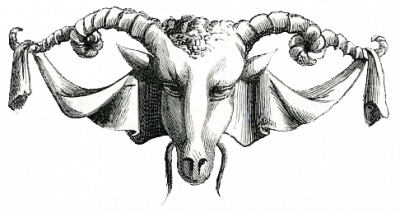
Continuing
Discover more from World4 Costume Culture History
Subscribe to get the latest posts sent to your email.

